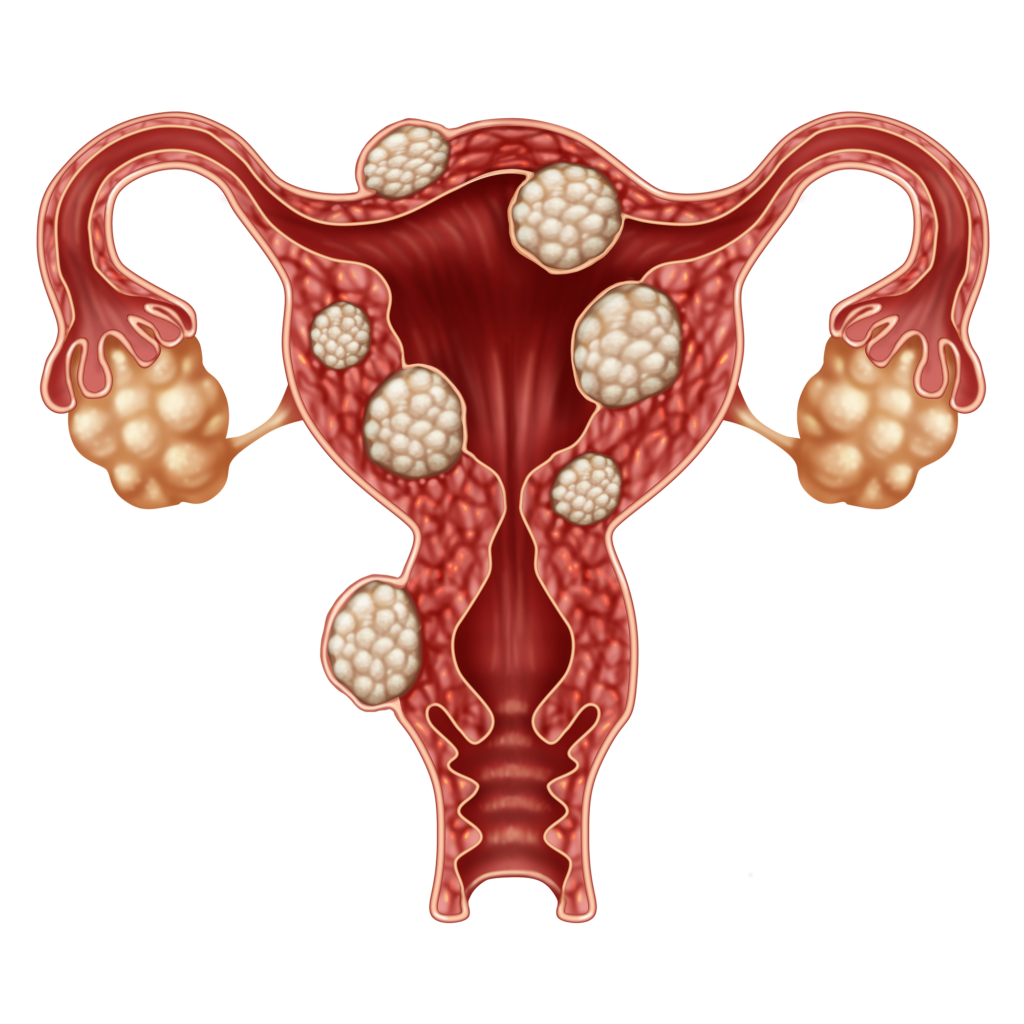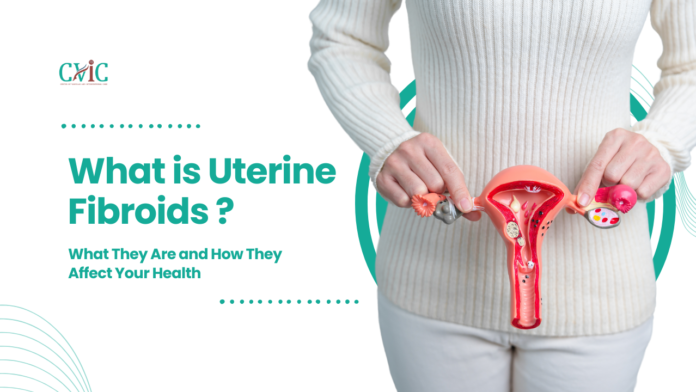Uterine fibroids, also known as leiomyomas or myomas, are non-cancerous growths that develop in or around the uterus. These growths are composed of muscle and fibrous tissue and can vary in size, from as small as a pea to as large as a melon. While uterine fibroids are typically benign, they can cause a range of health issues and significantly impact a woman’s quality of life. This comprehensive guide will explore what uterine fibroids are, their causes, symptoms, and the various treatment options available.
Understanding Uterine Fibroids
What Are Uterine Fibroids?
Uterine fibroids are common among women of reproductive age. These non-cancerous tumors arise from the smooth muscle tissue of the uterus. Depending on their location, fibroids can be classified into different types: intramural, submucosal, subserosal, and pedunculated.
- Intramural Fibroids: These develop within the muscular wall of the uterus.
- Submucosal Fibroids: These protrude into the uterine cavity.
- Subserosal Fibroids: These grow on the outside of the uterus.
- Pedunculated Fibroids: These are attached to the uterus by a thin stalk.
Causes of Uterine Fibroids
The exact cause of uterine fibroids is unknown, but several factors may contribute to their development:
- Hormonal Imbalances: Estrogen and progesterone, hormones that regulate the menstrual cycle, can promote the growth of fibroids.
- Genetic Factors: A family history of fibroids increases the likelihood of developing them.
- Growth Factors: Substances that help the body maintain tissues, such as insulin-like growth factor, may play a role.
- Extracellular Matrix (ECM): ECM is the material that helps cells stick together. It is more abundant in fibroids and makes them fibrous.

Symptoms of Uterine Fibroids
While some women with uterine fibroids experience no symptoms, others may have severe symptoms that interfere with daily life. Common symptoms include:
- Heavy Menstrual Bleeding: One of the most common symptoms is prolonged and heavy menstrual periods.
- Pelvic Pain and Pressure: Large fibroids can cause pain or a feeling of pressure in the pelvic region.
- Frequent Urination: As fibroids press on the bladder, they can cause frequent urination.
- Difficulty Emptying the Bladder: This is due to the pressure exerted by the fibroids.
- Constipation: Fibroids can press against the rectum, leading to constipation.
- Backache or Leg Pains: Large fibroids can press on nerves, causing pain in the back or legs.
Diagnosis of Uterine Fibroids
Diagnosing uterine fibroids typically involves a pelvic examination and imaging tests. Common diagnostic methods include:
- Ultrasound: Uses sound waves to create a picture of the uterus and can detect fibroids.
- Magnetic Resonance Imaging (MRI): Provides detailed images of the size and location of fibroids.
- Hysterosonography: Involves injecting saline into the uterus to enhance ultrasound images.
- Hysterosalpingography: Uses dye and X-rays to examine the inside of the uterus and fallopian tubes.
- Hysteroscopy: Involves inserting a small, lighted telescope through the cervix into the uterus.
How Uterine Fibroids Affect Your Health
Impact on Menstrual Cycle
Uterine fibroids can significantly impact the menstrual cycle. Many women with fibroids experience menorrhagia, which is heavy and prolonged menstrual bleeding. This can lead to anemia, a condition where the body does not have enough red blood cells to carry adequate oxygen to tissues, causing fatigue and weakness.
Reproductive Health Issues
Fibroids can affect fertility and pregnancy in several ways:
- Infertility: Fibroids can block the fallopian tubes, preventing sperm from reaching the egg.
- Pregnancy Complications: Fibroids can cause complications such as miscarriage, preterm birth, and abnormal fetal position.
- Labor and Delivery: Fibroids can interfere with the contractions of the uterus, leading to difficulties during labor.
Chronic Pain and Discomfort
Chronic pelvic pain is a common symptom of fibroids. This pain can be constant or intermittent and may be severe enough to interfere with daily activities. The size and location of the fibroids play a significant role in the severity of pain experienced.
Impact on Daily Life
Living with fibroids can be challenging. The symptoms can disrupt daily life, causing physical discomfort and emotional distress. Heavy bleeding can lead to frequent changes of sanitary products, and pain can limit activities and reduce quality of life.
Treatment Options for Uterine Fibroids
The treatment for uterine fibroids depends on the severity of symptoms, the size and location of the fibroids, and whether the woman wants to preserve fertility. Treatment options range from medications to surgical procedures.
Medications
Medications can help manage symptoms but do not eliminate fibroids. Common medications include:
- Gonadotropin-Releasing Hormone (GnRH) Agonists: These drugs reduce estrogen and progesterone levels, shrinking fibroids.
- Progestin-Releasing Intrauterine Device (IUD): Helps reduce heavy bleeding caused by fibroids.
- Nonsteroidal Anti-Inflammatory Drugs (NSAIDs): Help relieve pain but do not reduce bleeding.
- Tranexamic Acid: A non-hormonal medication that reduces menstrual bleeding.
Non-Surgical Procedures
Several non-surgical procedures can effectively treat fibroids:
- Uterine Artery Embolization (UAE): This procedure cuts off the blood supply to fibroids, causing them to shrink.
- Magnetic Resonance Guided Focused Ultrasound Surgery (MRgFUS): Uses high-intensity ultrasound waves to destroy fibroid tissue.
- Endometrial Ablation: Destroys the lining of the uterus to reduce heavy bleeding.
Surgical Procedures
For severe symptoms or large fibroids, surgery may be necessary:
- Myomectomy: The surgical removal of fibroids while preserving the uterus.
- Hysterectomy: The surgical removal of the uterus, which eliminates fibroids but also results in the inability to become pregnant.
- Laparoscopic or Robotic Myomectomy: Minimally invasive procedures to remove fibroids.
- Hysteroscopic Myomectomy: Removes fibroids through the cervix using a hysteroscope.
Living with Uterine Fibroids
Diet and Lifestyle Changes
Making certain lifestyle changes can help manage fibroid symptoms:
- Healthy Diet: Eating a balanced diet rich in fruits, vegetables, and whole grains can help manage symptoms. Avoiding processed foods and reducing red meat intake may also be beneficial.
- Regular Exercise: Regular physical activity can help reduce symptoms and improve overall health.
- Stress Management: Techniques such as yoga, meditation, and deep breathing can help manage stress, which may exacerbate symptoms.
Alternative Therapies
Some women find relief from fibroid symptoms through alternative therapies:
- Acupuncture: May help relieve pain and reduce fibroid size.
- Herbal Remedies: Certain herbs, such as green tea extract and Vitex, may help manage symptoms.
- Massage Therapy: Can help reduce pain and improve circulation.

Support and Counseling
Living with fibroids can be emotionally challenging. Seeking support from friends, family, or support groups can be beneficial. Counseling or therapy can help manage the emotional impact of fibroids and improve mental health.
Prevention and Early Detection
Regular Check-Ups
Regular gynecological check-ups are crucial for early detection and management of fibroids. Early detection can help manage symptoms and prevent complications.
Awareness of Risk Factors
Understanding the risk factors for fibroids can help in their prevention:
- Family History: Women with a family history of fibroids should be vigilant about regular check-ups.
- Hormonal Balance: Maintaining hormonal balance through a healthy lifestyle can help reduce the risk.
- Weight Management: Maintaining a healthy weight can reduce the risk of developing fibroids.
Future Directions in Fibroid Research
Research on uterine fibroids is ongoing, with new treatments and diagnostic methods being developed. Future research may focus on:
- Genetic Studies: Understanding the genetic basis of fibroids can lead to targeted therapies.
- Hormonal Treatments: Developing new hormonal treatments with fewer side effects.
- Minimally Invasive Procedures: Advancements in minimally invasive techniques for fibroid removal.
Conclusion
Uterine fibroids are a common condition that can significantly impact a woman’s health and quality of life. Understanding the causes, symptoms, and treatment options is crucial for managing this condition. With advances in medical research, there are now more options than ever for effectively treating fibroids and improving the lives of those affected. Regular check-ups, a healthy lifestyle, and awareness of risk factors can help in the early detection and management of fibroids, ensuring better health outcomes for women.
FAQs
What are uterine fibroids?
Uterine fibroids are non-cancerous growths that develop in or around the uterus, composed of muscle and fibrous tissue.
What causes uterine fibroids?
The exact cause is unknown, but factors like hormonal imbalances, genetic predisposition, and growth factors may contribute to their development.
What are the symptoms of uterine fibroids?
Common symptoms include heavy menstrual bleeding, pelvic pain, frequent urination, constipation, and backache.
How are uterine fibroids diagnosed?
Diagnosis typically involves a pelvic exam and imaging tests such as ultrasound, MRI, hysterosonography, hysterosalpingography, and hysteroscopy.
What are the treatment options for uterine fibroids?
Treatment options include medications, non-surgical procedures (UAE, MRgFUS, endometrial ablation), and surgical procedures (myomectomy, hysterectomy).
Can lifestyle changes help manage uterine fibroid symptoms?
Yes, a healthy diet, regular exercise, and stress management can help reduce symptoms and improve overall health.

Our Doctors
Dedicated IR Center for Vascular Problems in Madhya Pradesh
DR. SHAILESH GUPTA
MD, PDCC (INTERVENTIONAL RADIOLOGY) Consultant & Co-Director CVIC (Center Of Vascular & Interventional Care)
DR. ALOK KUMAR UDIYA
MD Radiology, PDCC (Neurointervention Radiology), PDCC ( HPB Intervention Radiology) FINR (Switzerland) & EBIR
Endovascular Surgeon & Consultant Interventional Neuroradiologist at Care CHL Hospital, Indore Co-director CVIC( center for vascular and interventional care)
DR. NISHANT BHARGAVA
Consultant Intervention Radiologist
MD Radiology, PDCC ( Neurointervention Radiology), FINR ( Fellowship in Neurointervention Radiology)
Co-director CVIC(Center for Vascular and Interventional Care)
Contact Details
Phone no.
0731 4675670
+91 9827760073
Facebook
https://www.facebook.com/profile.php?id=100092538633553&mibextid=ZbWKwL
Instagram
https://instagram.com/cvic_center?igshid=ZGUzMzM3NWJiOQ==
Google My business
https://g.co/kgs/DrdV3T
YouTube
https://www.youtube.com/channel/UCP5TH5e4iQZkpDUgnLsgZhw
Pinterest
https://pin.it/5DzpX5Z
Twitter
https://x.com/cviccenter?t=01TclSrLFdu0K2re0Gs96w&s=08
LINKEDIN
https://www.linkedin.com/company/center-of-vascular-interventional-care/
Location –
Read More –
Living with a Metallic Stent: What to Expect and How to Adapt – https://cvicvascular.com/living-with-a-metallic-stent-what-to-expect-and-how-to-adapt/
The Benefits of Bleeder Embolization: Why Choose This Treatment? – https://cvicvascular.com/benefits-of-bleeder-embolization-why-choose-this-treatment/
Comprehensive Guide to Varicose Veins: Causes, Symptoms, and Treatment Options – https://cvicvascular.com/varicose-veins-causes-symptoms-treatment-options/




